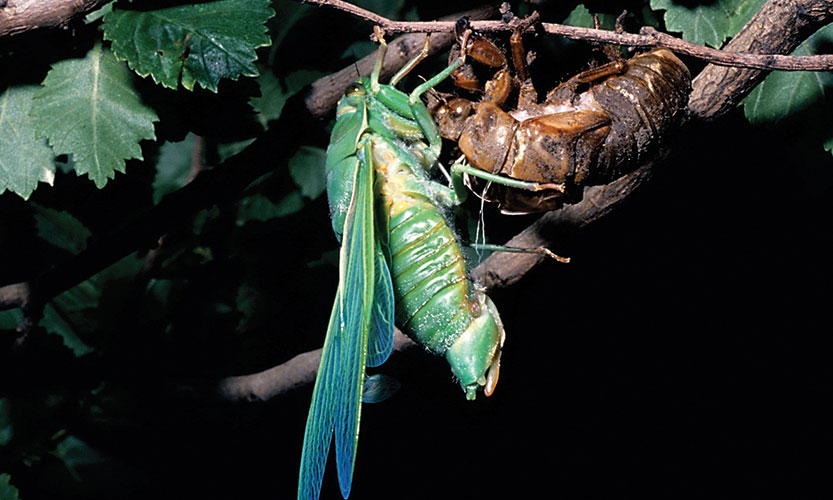Summer drummer
Later this month when you hear the thunderous roar of cicadas in the Flagstaff or Parkville Gardens remember they have probably been working up to it for seven years.
That’s how long most species of Australian cicadas sit in their tiny holes underground as nymphs, sucking sap from their host tree in the dark, waiting for their environmental alarm clock to ring, slowly growing from one month to the next. If you think that’s a long time to live such a life, some American species take up to 17 years to mature (obviously slow learners).
Every year, like the cicadas, I wait for the first really warm night in November. As soon as it’s dark I pop over to one of the local parks with my torch and camera gear and examine the ground around the trees. If I’m lucky, I might see a five-centimetre-long adult using its specially designed front legs to dig its way to the surface, climb doggedly up the trunk and set itself for its coming of age. The back of the brown casing splits down the middle and like a slow-motion version of the mild-mannered Clark Kent emerging from his phone booth as Superman, out struggles a somewhat crumpled adult cicada. Usually yellow, less often green and occasionally black, its wings still to unfurl, quite some time transpires before the cicada is ready to fly. Generally, content to climb its way up into the canopy it will soon be completely hidden from view and safe from most predators.
Bumbling, loveable and harmless, these insects live only a few weeks – just long enough to mate, the female laying a couple of hundred eggs, employing the pointy ovipositor on the end of her abdomen to neatly deposit each egg into its own individual slit in a tree branch, and then die. When the eggs hatch, the nymphs fall to the ground, burrow into the ground and begin the cycle all over again.
There is a theory, well, it’s mine actually, that male cicadas have a strong genetic link with boys, both the young and teenage varieties. The noise the male cicadas make with their abdominal plates act like the clackers of our childhood, except a cicada clacks at 600 times per second which, thankfully, even the most diligent eight-year-old thankfully cannot manage.
Cicadas possess the most complicated auditory system in the insect world and like most teenagers, are actually oblivious to their own noise. The level has been measured at 120 decibels, which at a distance of one metre or so, is actually on the threshold of human pain. Reminiscent again you might say of the noise permeating all homes which have paper thin doors leading to teenage bedrooms.
With eyesight which can only distinguish between light and dark and an ability to fly only about as well as the Wright brothers, cicadas are easy prey for birds, and although their sound has a ventriliquistic nature in the bush, making it almost impossible to determine their exact location, once on the wing that incredible sound makes them an easy target.
Australia is the cicada capital of the world with more than 700 species and I’ve noticed, like most insect species, there appears to be a cycle of good and bad years. In the past, on occasions, I have found literally hundreds within an area of about 100 square metres, whereas in recent times I’m lucky to find a dozen. I wonder if global warming is having an effect?
What function these chubby chaps have in nature is a mystery, but along with tadpoles and ladybirds they certainly fill a need in all keen young collectors. What would we do without them?
If you would like to see more of my work, click here or check out my YouTube channel under my name •

Jo Ryan unveils Ordered Chaos at Blender Studios





 Download the Latest Edition
Download the Latest Edition